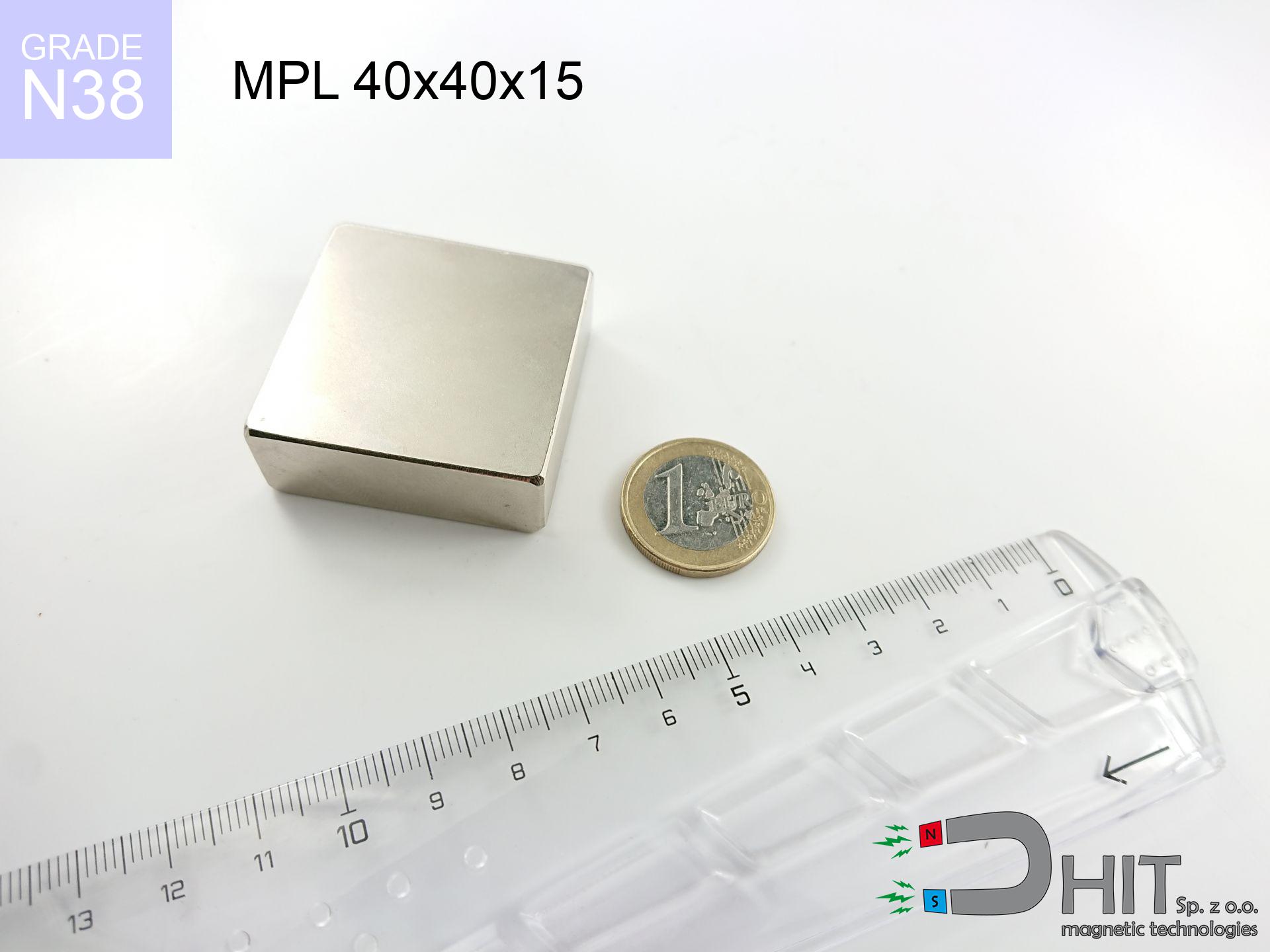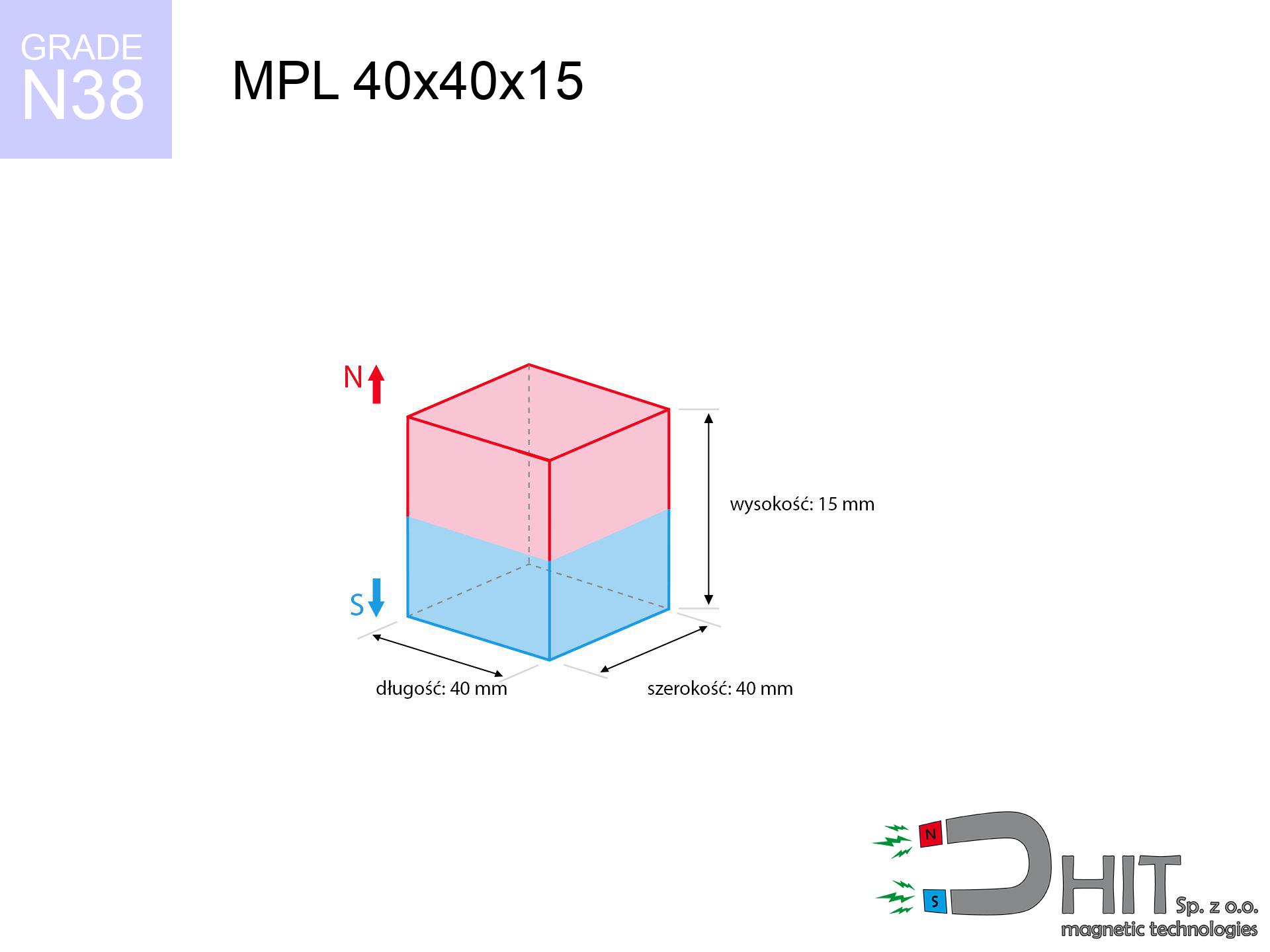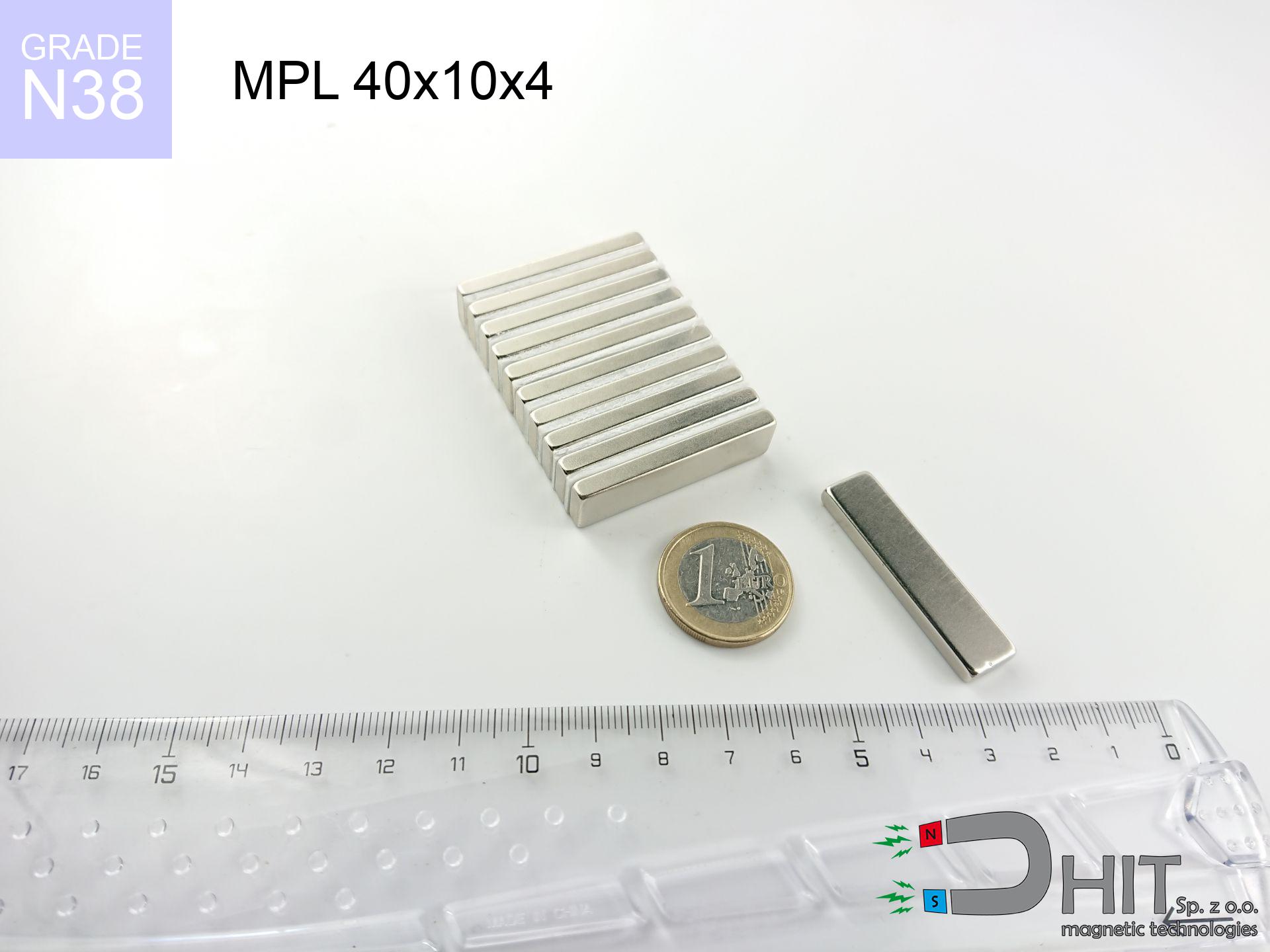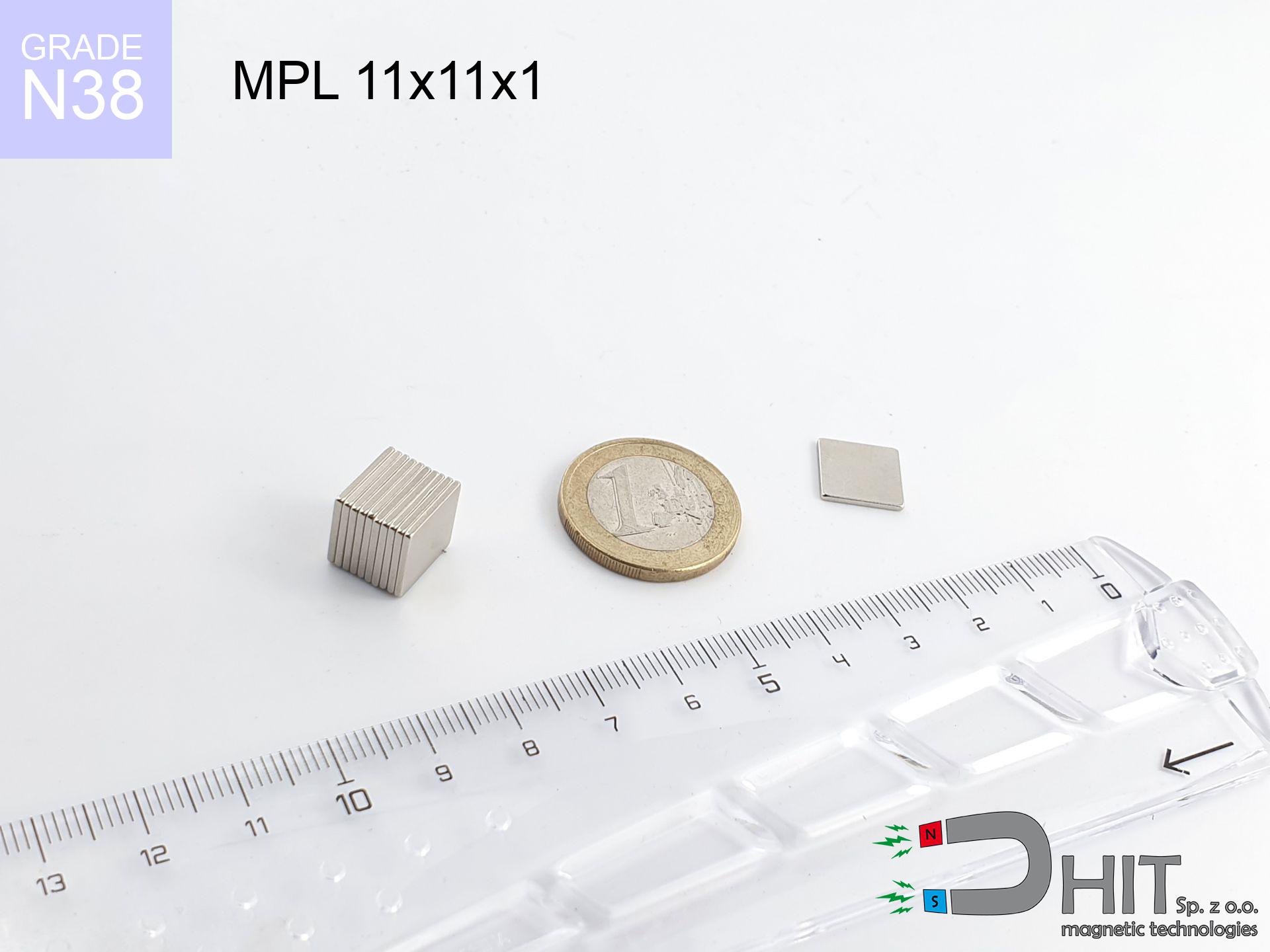MPL 40x40x15 / N38 - lamellar magnet
lamellar magnet
Catalog no 020161
GTIN: 5906301811671
length
40 mm [±0,1 mm]
Width
40 mm [±0,1 mm]
Height
15 mm [±0,1 mm]
Weight
180 g
Magnetization Direction
↑ axial
Load capacity
47.38 kg / 464.64 N
Magnetic Induction
345.80 mT
Coating
[NiCuNi] nickel
55.37 ZŁ with VAT / pcs + price for transport
45.02 ZŁ net + 23% VAT / pcs
bulk discounts:
Need more?Not sure which magnet to buy?
Contact us by phone
+48 888 99 98 98
otherwise send us a note by means of
request form
the contact form page.
Parameters along with appearance of magnetic components can be tested with our
magnetic calculator.
Same-day processing for orders placed before 14:00.
Magnetic properties of material N38
Physical properties of sintered neodymium magnets Nd2Fe14B at 20°C
Shopping tips
Advantages as well as disadvantages of rare earth magnets.
Besides their magnetic performance, neodymium magnets are valued for these benefits:
- They have unchanged lifting capacity, and over more than 10 years their performance decreases symbolically – ~1% (in testing),
- They are noted for resistance to demagnetization induced by external magnetic fields,
- By covering with a decorative layer of nickel, the element gains an proper look,
- The surface of neodymium magnets generates a intense magnetic field – this is one of their assets,
- Thanks to resistance to high temperature, they are able to function (depending on the shape) even at temperatures up to 230°C and higher...
- Possibility of exact machining and adapting to precise requirements,
- Huge importance in high-tech industry – they find application in magnetic memories, motor assemblies, advanced medical instruments, as well as multitasking production systems.
- Thanks to concentrated force, small magnets offer high operating force, occupying minimum space,
Drawbacks and weaknesses of neodymium magnets: application proposals
- At strong impacts they can break, therefore we advise placing them in special holders. A metal housing provides additional protection against damage and increases the magnet's durability.
- NdFeB magnets demagnetize when exposed to high temperatures. After reaching 80°C, many of them experience permanent drop of power (a factor is the shape and dimensions of the magnet). We offer magnets specially adapted to work at temperatures up to 230°C marked [AH], which are extremely resistant to heat
- Due to the susceptibility of magnets to corrosion in a humid environment, we advise using waterproof magnets made of rubber, plastic or other material stable to moisture, in case of application outdoors
- Due to limitations in realizing nuts and complex shapes in magnets, we propose using cover - magnetic mount.
- Possible danger resulting from small fragments of magnets are risky, if swallowed, which becomes key in the context of child health protection. Additionally, tiny parts of these products are able to complicate diagnosis medical when they are in the body.
- Higher cost of purchase is a significant factor to consider compared to ceramic magnets, especially in budget applications
Maximum lifting force for a neodymium magnet – what contributes to it?
The specified lifting capacity refers to the maximum value, recorded under optimal environment, namely:
- on a plate made of structural steel, optimally conducting the magnetic flux
- whose thickness equals approx. 10 mm
- with a surface free of scratches
- with zero gap (without impurities)
- under vertical force vector (90-degree angle)
- at ambient temperature room level
Lifting capacity in practice – influencing factors
Bear in mind that the magnet holding may be lower influenced by the following factors, starting with the most relevant:
- Distance – existence of any layer (rust, tape, air) interrupts the magnetic circuit, which lowers power steeply (even by 50% at 0.5 mm).
- Direction of force – highest force is reached only during perpendicular pulling. The resistance to sliding of the magnet along the plate is typically several times lower (approx. 1/5 of the lifting capacity).
- Substrate thickness – to utilize 100% power, the steel must be adequately massive. Thin sheet limits the lifting capacity (the magnet "punches through" it).
- Chemical composition of the base – low-carbon steel attracts best. Alloy admixtures decrease magnetic permeability and holding force.
- Surface structure – the more even the plate, the larger the contact zone and higher the lifting capacity. Unevenness acts like micro-gaps.
- Thermal factor – hot environment reduces magnetic field. Exceeding the limit temperature can permanently damage the magnet.
* Lifting capacity was measured with the use of a smooth steel plate of optimal thickness (min. 20 mm), under perpendicular pulling force, in contrast under attempts to slide the magnet the lifting capacity is smaller. In addition, even a minimal clearance {between} the magnet’s surface and the plate lowers the load capacity.
Safe handling of neodymium magnets
Pinching danger
Risk of injury: The attraction force is so immense that it can cause blood blisters, crushing, and broken bones. Protective gloves are recommended.
Fire warning
Fire warning: Rare earth powder is explosive. Do not process magnets without safety gear as this may cause fire.
Keep away from computers
Do not bring magnets near a purse, computer, or screen. The magnetic field can destroy these devices and erase data from cards.
Keep away from children
These products are not intended for children. Accidental ingestion of several magnets may result in them attracting across intestines, which constitutes a severe health hazard and necessitates urgent medical intervention.
Medical implants
Life threat: Neodymium magnets can deactivate heart devices and defibrillators. Stay away if you have electronic implants.
GPS Danger
Navigation devices and smartphones are extremely susceptible to magnetic fields. Direct contact with a powerful NdFeB magnet can permanently damage the internal compass in your phone.
Safe operation
Handle with care. Neodymium magnets attract from a long distance and connect with massive power, often faster than you can react.
Do not overheat magnets
Avoid heat. Neodymium magnets are sensitive to temperature. If you need resistance above 80°C, ask us about special high-temperature series (H, SH, UH).
Nickel allergy
Studies show that the nickel plating (the usual finish) is a strong allergen. If your skin reacts to metals, avoid touching magnets with bare hands and select versions in plastic housing.
Beware of splinters
Despite the nickel coating, neodymium is delicate and cannot withstand shocks. Do not hit, as the magnet may shatter into sharp, dangerous pieces.
Caution!
Looking for details? Read our article: Are neodymium magnets dangerous?




![SM 25x250 [2xM8] / N52 - magnetic separator SM 25x250 [2xM8] / N52 - magnetic separator](https://cdn3.dhit.pl/graphics/products/sm-25x250-2xm8-sam.jpg)


![UMH 16x5x32 [M4] / N38 - magnetic holder with hook UMH 16x5x32 [M4] / N38 - magnetic holder with hook](https://cdn3.dhit.pl/graphics/products/umh-16x5x32-m4-lak.jpg)

